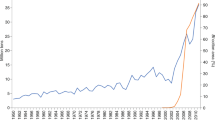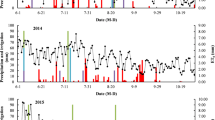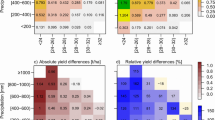Abstract
American cotton (Gossypium hirsutum L.), transformed with Bacillus thuringiensis Cry genes (Bt G. hirsutum) that confer resistance to lepidopteran pests, is extensively cultivated worldwide. In India, transgenic Bt G. hirsutum was commercially released in 2002 and by 2014 95% of farmers had adopted Bt G. hirsutum1. The economic benefits of Bt G. hirsutum over non-Bt G. hirsutum are well documented and include increase in yields, increase in farmers' net revenue and reduction in pesticide application against lepidopteran pests2–9. However, it is unclear to what extent irrigation influences the performance of Bt G. hirsutum on smallholder farming in India, and if, in the absence of irrigation, growing Bt G. hirsutum provides greater economic benefits for Indian smallholder farmers compared with growing the Asiatic cotton Gossypium arboreum L. Here, we compare the economic impact of growing Bt G. hirsutum with growing G. arboreum under rainfed conditions in the Indian state of Maharashtra, and show that G. arboreum can generate similar net revenue, and thus similar economic benefits for smallholder farmers compared with growing Bt G. hirsutum. We also compare the economic impact of growing Bt G. hirsutum under rainfed conditions with growing Bt G. hirsutum under irrigated conditions and show that even though Bt G. hirsutum yields increase with irrigation, the net revenue does not significantly increase because farmers using irrigation spend significantly more than farmers growing Bt G. hirsutum without irrigation. We conclude that our data provide a broader insight into how socio-economic data needs to be incorporated into agro-ecological data when planning strategies to improve cotton farming in India.
This is a preview of subscription content, access via your institution
Access options
Subscribe to this journal
Receive 12 digital issues and online access to articles
$119.00 per year
only $9.92 per issue
Buy this article
- Purchase on Springer Link
- Instant access to full article PDF
Prices may be subject to local taxes which are calculated during checkout


Similar content being viewed by others
References
James, C. Global Status of Commercialized Biotech/GM Crops: 2014. Brief No. 49 (ISAAA, 2014).
Qaim, M. & Zilberman, D. Yield effects of genetically modified crops in developing countries. Science 299, 900–902 (2003).
Morse, S., Bennett, R. M. & Ismael, Y. Genetically modified insect resistance in cotton: some farm level economic impacts in India. Crop Prot. 24, 433–440 (2005).
Bennett, R., Kambhampati, U., Morse, S. & Ismael, Y. Farm-level economic performance of genetically modified cotton in Maharashtra, India. Rev. Agr. Econ. 28, 59–71 (2006).
Qaim, M., Subramanian, A., Naik, G. & Zilberman, D. Adoption of Bt cotton and impact variability: insights from India. Rev. Agr. Econ. 28, 48–58 (2006).
Carpenter, J. Peer-reviewed surveys indicate positive impact of commercialized GM crops. Nature Biotechnol. 28, 319–321 (2010).
Kouser, S. & Qaim, M. Impact of Bt cotton on pesticide poisoning in smallholder agriculture: A panel data analysis. Ecol. Econ. 70, 2105–2113 (2011).
Stone, G. Field versus farm in Warangal: Bt cotton, higher yields, and larger questions. World Dev. 39, 387–398 (2011).
Kathage, J. & Qaim, M. Economic impacts and impact dynamics of Bt (Bacillus thuringiensis) cotton in India. Proc. Natl Acad. Sci. USA 109, 11652–11656 (2012).
Gill, S. S., Singh, S. & Brar, J. S. in Economic and Environmental Sustainability in the Asian Region (eds Gill, S. S., Singh, L. & Marwah, R. ) 419–442 (Routledge, 2010).
Kulkarni, V. N., Khadi, B. M., Maralappanavar, M. S., Deshapande, L. A. & Narayanan, S. S. in Genetics and Genomics of Cotton, Plant Genetics and Genomics: Crops and Models (ed. Paterson, A. H. ) 69–97 (Springer, 2009).
Khadi, B. M., Santhy, V. & Yadav, M. S. in Cotton: Biotechnological Advances (ed. Zehr, U. B. ) 15–40 (Springer, 2010).
Maqbool, A. et al. Identification and expression of six drought-responsive transcripts through differential display in Desi cotton (Gossypium arboreum). Mol. Biol. 42, 492–498 (2008).
Kalamkar, S. S. in Agricultural Growth and Productivity in Maharashtra. Trends and Determinants Ch. 4 (Allied Publishers, 2011).
Kumar, R., Singh, R. D. & Sharma, K. D. Water resources in India. Curr. Sci. India 89, 794–811 (2005).
Rodell, M., Velicogna, I. & Famiglietti, J. S. Satellite-based estimates of groundwater depletion in India. Nature 460, 999–1003 (2009).
Elliott, J. et al. Constraints and potentials of future irrigation water availability on agricultural production under climate change. Proc. Natl Acad. Sci. USA 111, 3239–3244 (2014).
Jayaraman, K. Poor crop management plagues Bt cotton experiment in India. Nature Biotechnol. 20, 1069 (2002).
Cattaneo, M. et al. Farm-scale evaluation of the impacts of transgenic cotton on biodiversity, pesticide use, and yield. Proc. Natl Acad. Sci. USA 103, 7571–7576 (2006).
Viswanathan, P. K. & Lalitha, N. in Economic and Environmental Sustainability in the Asian Region (eds Gill, S. S., Singh, L. & Marwah, R. ) 391–418 (Routledge, 2010).
Sharma, H., Agarwal, R. & Singh, M. Effect of some antibiotic compounds in cotton on post-embryonic development of spotted bollworm (Earias vittella F.) and the mechanism of resistance in Gossypium arboreum. Proc. Indian Acad. Sci. (Anim. Sci.) 91, 67–77 (1982).
Nibouche, S., Brevault, T., Klassou, C., Dessauw, D. & Hau, B. Assessment of the resistance of cotton germplasm (Gossypium spp.) to aphids (Homoptera, Aphididae) and leafhoppers (Homoptera: Cicadellidae, Typhlocybinae): methodology and genetic variability. Plant Breed. 127, 376–382 (2008).
Akhtar, K. P. et al. Evaluation of Gossypium species for resistance to cotton leaf curl Burewala virus. Ann. Appl. Biol. 157, 135–147 (2010).
Miyazaki, J., Stiller, W. N. & Wilson, L. J. Novel cotton germplasm with host plant resistance to twospotted spider mite. Field Crop Res. 134, 114–121 (2012).
Ahuja, S. L. et al. Development of Gossypium hirsutum lines with cytoplasmic bollworm tolerance from Gossypium arboreum and Gossypium tomentosum. Plant Breed. 128, 712–715 (2009).
Chandra, M. & Sreenivasan, S. Studies on improved cotton: Part I – Fibre quality parameters. Ind. J. Fibre Textile Res. 36, 24–34 (2011).
Kranthi, K. R. Long Live Swadesi Cotton. Cotton Statistics and News (Cotton Association of India, 2013).
Dadgale, P. R. et al. Productivity and quality of Bt cotton (Gossypium hirsutum) as influenced by planting geometry and nitrogen levels under irrigated and rainfed conditions. Indian J. Agr. Sci. 84, 1069–1072 (2014).
Stone, G. Agricultural deskilling and the spread of genetically modified cotton in Warangal. Curr. Anthropol. 48, 67–103 (2007).
Burnham, K. P. & Anderson, D. R. Model Selection and Multimodel Inference: a Practical Information-Theoretic Approach (Springer-Verlag, 2002).
R Development Core Team R: A Language and Environment for Statistical Computing (R Foundation for Statistical Computing, 2013).
Acknowledgements
Sincere thanks go to V. Ladole and all his team from the Indian NGO ‘Community Action for Rural Development’, whose collaboration was key to the success of this study. We especially thank S. Ladole, R. Ramrao, H-H. Tao, D. Jorda and M. Manoj for helping us with the fieldwork. This research was funded by the John Templeton Foundation.
Author information
Authors and Affiliations
Contributions
All authors contributed to the study design and are responsible for the integrity of the work as a whole. L.D. and K.W. secured funding for the project. C.R.D. did the fieldwork and analysed and interpreted the data along with M.B.B. C.R.D. wrote the manuscript with the input of all co-authors, especially L.D.
Corresponding authors
Ethics declarations
Competing interests
The authors declare no competing financial interests.
Supplementary information
Rights and permissions
About this article
Cite this article
Romeu-Dalmau, C., Bonsall, M., Willis, K. et al. Asiatic cotton can generate similar economic benefits to Bt cotton under rainfed conditions. Nature Plants 1, 15072 (2015). https://doi.org/10.1038/nplants.2015.72
Received:
Accepted:
Published:
DOI: https://doi.org/10.1038/nplants.2015.72
This article is cited by
-
The cost of native and GM cotton crops
Nature (2015)



